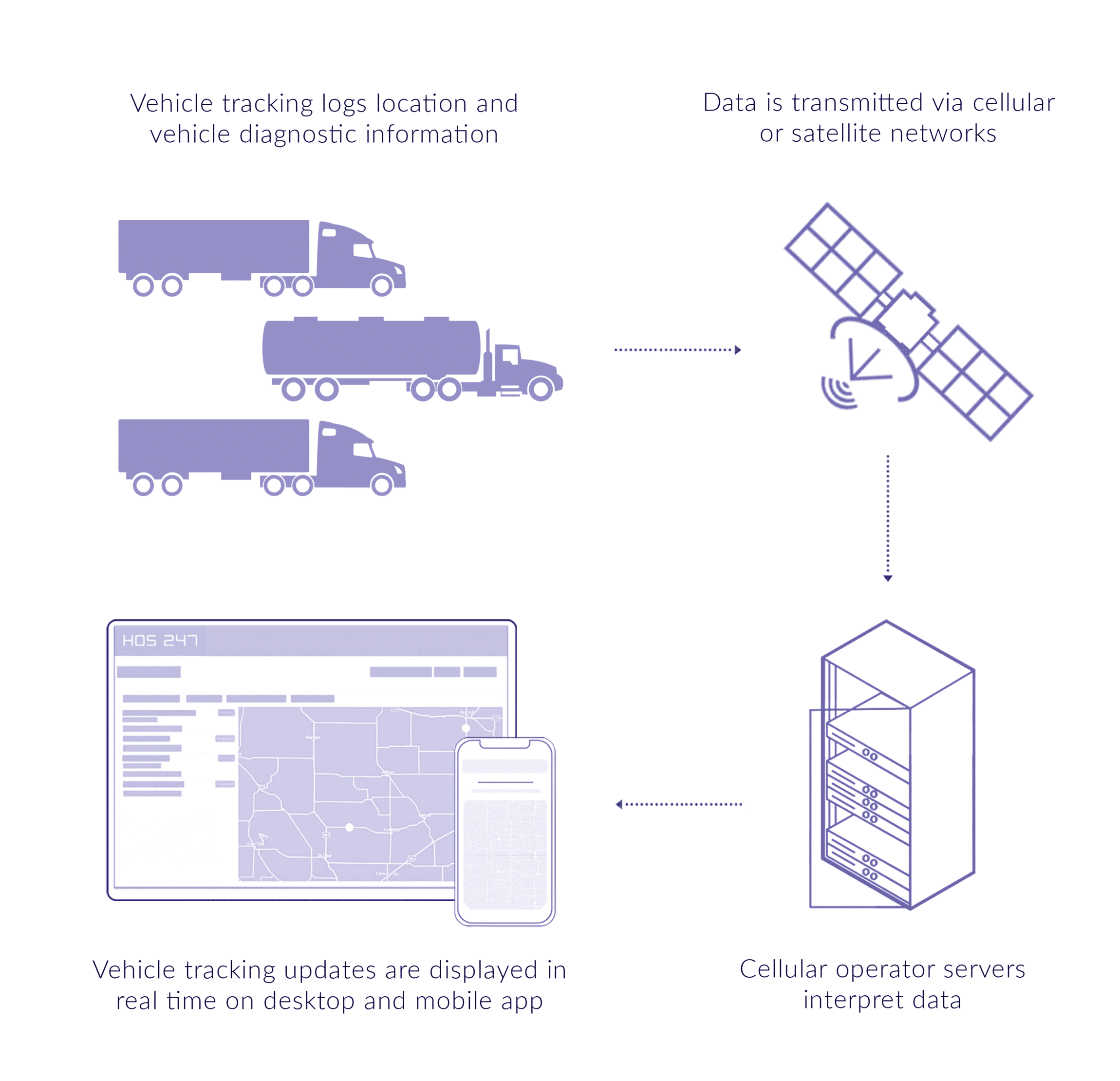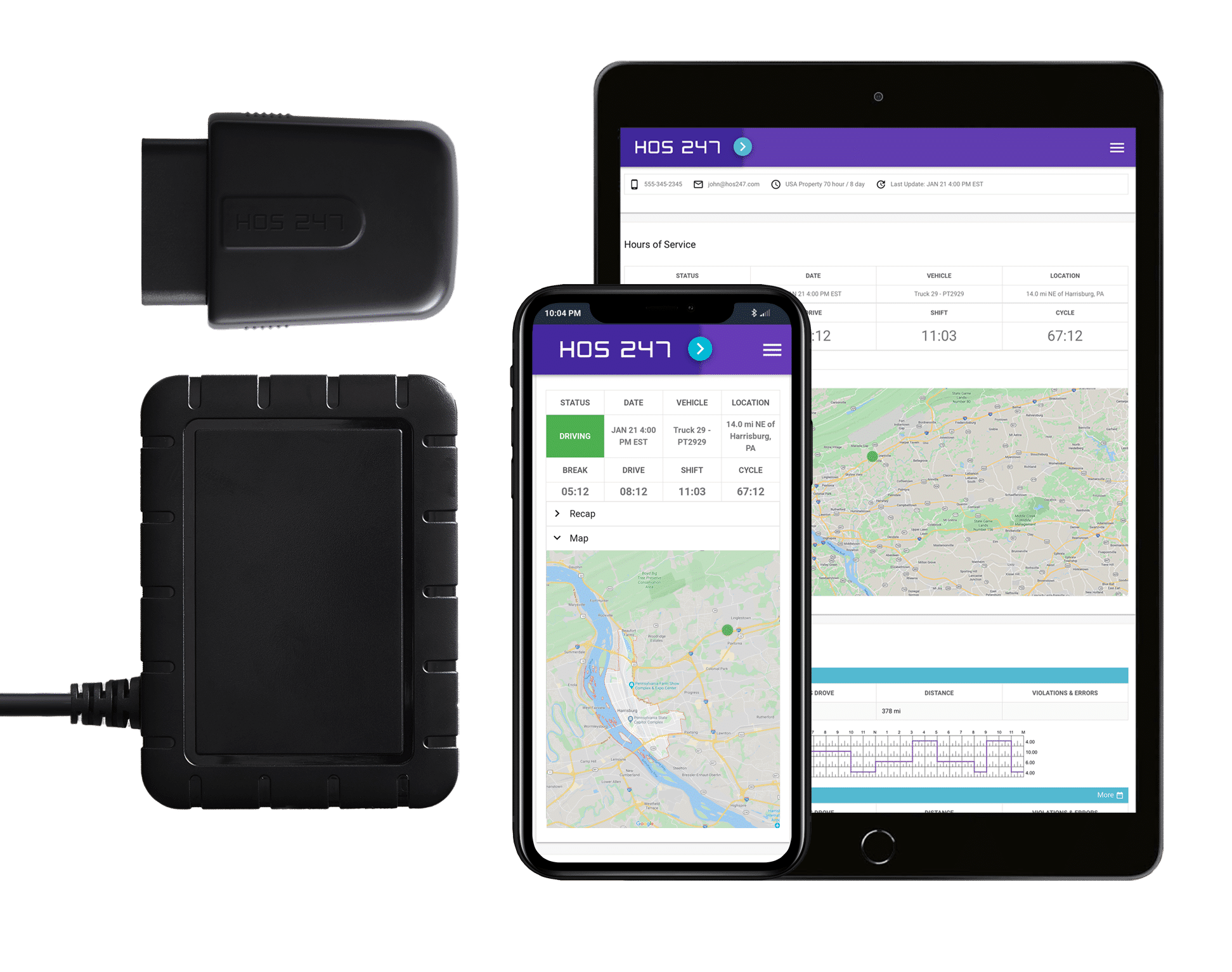There are different types of fleet tracking devices available on the market; though all of them offer GPS services, their functionality may vary, so it is important to choose a suitable option depending on your fleet’s size and particular business needs.
For instance, some fleet tracking devices are smaller and easier to rotate between vehicles due to a simple installation process, while more complex devices provide better connectivity but might need special installation. In this article, we will talk about types of trackers and what they offer to help you choose the right one for your trucking business.
What Are Fleet Tracking Devices?
Whether you operate five trucks or fifty, “fleet tracking” can mean different things depending on the provider. To choose the right setup — and avoid paying for features you don’t need — it helps to define what fleet tracking actually includes and how the pieces work together.
Fleet Tracking vs. Basic GPS
First, let’s align on terms. When most people hear “GPS,” they think of turn-by-turn directions on a phone. Fleet tracking is different. It combines GPS with vehicle-installed hardware and back-office software to deliver live visibility, engine and sensor data (telematics), alerts, reports, and integrations your dispatch and safety teams can act on.
Modern trackers read data from the engine control module (ECM). With the right software, that data powers maintenance reminders, IFTA mileage automation, geofence alerts, proof of service, and, when paired with an ELD, easier HOS recordkeeping.
Do you have any questions? Talk to ELD Advisor: 650-405-3372 or Request Callback
Real-Time vs. Passive Tracking
Tracking can be real-time or passive. Real-time systems transmit location and status at frequent intervals (e.g., every 30–120 seconds) over a cellular network for live visibility — great for dispatching, customer ETAs, and theft recovery. Passive systems store data locally and upload later, which reduces connectivity costs but limits live decision-making. Many fleets prefer real-time for trucks and use passive or lower-frequency reporting for trailers and remote assets.
Core Components
Key components typically include:
- Hardware. Plug-and-play OBD/J1939 trackers, hardwired units (often with backup batteries), and battery-powered asset trackers.
- Software. A web dashboard and mobile apps for dispatchers and managers, plus configurable alerts and reports.
- Connectivity. GPS for positioning and cellular data for transmission; smart reporting profiles balance update frequency with cost and privacy.
- Integrations. ELD platforms, TMS/dispatch, maintenance systems, and APIs to bring data into existing workflows.
In short, a fleet tracker is a tool that connects vehicles, drivers, and office teams with actionable data. Used well, it improves routing, reduces fuel waste and downtime, protects drivers and assets, and gives customers reliable ETAs —turning raw location pings into operational results.
Advantages and Disadvantages of Different Types of GPS Trackers
There are three types of tracking devices that can be used to monitor fleets: plug-in, hardwired and battery-operated. All three provide vehicle location information, but they operate differently. In this section, we will discuss the advantages and shortcomings of every type of tracker to help you make the right choice.

Plug-In Trackers
A plug-and-play tracker is a small GPS device installed directly into the vehicle’s port to report the location when it is switched on. Integrated with an ELD, this device can ensure compliance with the mandate and safety guidelines.
Pros: These devices are easy to install and maintain, so motor carriers can move them between different vehicles in the fleet, saving money on buying a tracker for each truck.
Cons: The tracker does not capture GPS data if the vehicle is turned off, so the surveillance is not 24/7.
Hardwired Trackers
A hardwired vehicle tracking device is designed for professional vehicles and heavy equipment monitoring. These devices are wired into the vehicle’s system and can be hidden for security purposes.
Pros: Hardwired trackers provide more accurate GPS information. These devices are relatively easy to install and tamper-proof because they can be concealed inside the truck, helping recover stolen assets.
Cons: Once the device is installed, it can be difficult to remove for maintenance. Also, location data is only available when the vehicle is on.
Battery-Operated Trackers
Solely powered off its internal battery, a battery-operated tracker is often used for uninterrupted GPS location tracking of remote assets such as containers.
Pros: These trackers can work without maintenance for long periods of time, operating even when the vehicle is completely turned off—an excellent choice for motor carriers who need their fleet to be monitored around the clock.
Cons: In order to save battery power, these devices may share location information less frequently.
Each tracker type serves different fleet needs. The choice depends on your specific requirements for installation flexibility, monitoring coverage, and operational priorities.

HOS247 Fleet Tracking Devices
HOS247 offers both ELD-integrated & hardwired tracking devices with a battery. Our tracking devices for fleets collect GPS coordinates between 30 seconds and 2 minutes to provide real-time monitoring. Let’s dive deeper into the characteristics of each tracker:
- ELD-integrated tracker. This tracker is a plug-and-play type that Integrates with an electronic logging device to facilitate compliance with the ELD law, helping avoid HOS violations and costly penalties. These devices have a simple installation process: they are set up by plugging them to the vehicle’s OBD2 port—an excellent choice for business owners who want to use the same device in different vehicles.
- 24/7 monitoring tracker. HOS247 hardwired fleet tracking devices are enhanced with a separate battery to collect and transfer GPS real-time data even when the vehicle is turned off. The installation process takes under 10 minutes and the tracker can be concealed to prevent tampering and recover the truck and assets in case of theft. The vehicle data is recorded apart from the driver data, which means that GPS information is accessible even when the driver is off-duty.
Both HOS247 tracking options provide the real-time visibility and compliance tools trucking companies need, with the flexibility to choose between portable ELD integration or permanent hardwired installation based on your fleet’s operational requirements.
Benefits of the HOS247 4G GPS Tracking System
HOS247 provides excellent fleet monitoring services with all tracking devices. Known for its efficiency, our tracking system uses reliable technology to achieve maximum accuracy. The 4G network provides ten times faster connectivity than 3G, and, even after 5G is rolled out, our GPS fleet tracking devices will operate flawlessly since the 4G LTE network serves as a solid base for 5G connectivity.
Besides, our hardwired trackers use telematics technology to transfer the collected data even in remote areas and during challenging weather conditions. Here are other benefits fleet owners enjoy from using HOS247 trackers:
- Top-rated customer support. HOS247 offers efficient technical assistance Monday through Sunday to help you with any questions about installation, usage and troubleshooting. We speak English, Spanish, Polish, and Russian to improve communication with our customers.
- Real-time tracking for optimizing fleet operations. Strong GPS signal allows motor carriers to monitor their vehicles 24/7. With precise information about vehicles’ location, dispatchers can plan routes more efficiently, avoiding traffic caused by accidents or construction sites. They can save time and increase the productivity of operations by assigning the task to the driver who is closer to a load and has sufficient available driving hours. Customers also get a chance to track their assets in real-time, knowing exactly when the vehicle will arrive; transparency in communication leads to improved customer service.
- Increased truck and driver security. Our system notifies fleet managers in case the vehicle is driven to an unauthorized location or gets into an accident, helping make timely decisions and recover stolen assets. Collected data may also protect the driver from false claims: the GPS fleet tracking device will indicate the accurate time a vehicle arrived at the site and when it left.
- Savings on vehicle maintenance. The HOS247 system helps to ensure a vehicle’s compliance with safety guidelines. Our GPS fleet tracking device informs fleet managers when the vehicle is due for maintenance, considerably reducing expenses related to repairs or downtime and prolonging the truck’s longevity.
Together, these benefits demonstrate why HOS247’s 4G tracking system is more than just a compliance tool — it’s a comprehensive solution that enhances every aspect of fleet operations. From protecting your drivers and assets to reducing operational costs and improving customer satisfaction, our tracking technology delivers measurable results that directly impact your bottom line.
HOS247 GPS Tracking Features

HOS247 is equipped with a set of features that improve fleet productivity, facilitating the work of drivers and fleet managers and helping reduce operational costs. These include:
- Vehicle diagnostics. Streamlined vehicle diagnostics use an alert system to notify drivers and fleet managers about maintenance events such as tire rotations, oil changes, warranty expirations, license renewals, etc. Based on mileage, hours of usage data, and past service history, the system will schedule preventative maintenance automatically to prevent breakages.
- Fault code detection. This feature also contributes to vehicle health by notifying a driver about a malfunction through the system of codes. When a fault is detected, it generates a specific trouble code, transmitting the alert to the vehicle’s instrument panel as a warning light and directly to the office through the fleet manager portal.
- Automated idle tracking. The idle reporting feature informs fleet managers of excessive idling so they can coach operators on improving their driving habits, cutting fuel expenses and reducing the company’s carbon footprint.
- Automated IFTA state mileage calculations. Reduce human error and the risk of being audited with this HOS247 feature. It helps eliminate the administrative paperwork burden, facilitating tax reporting.
- ELD integration. Our fleet tracking devices can be integrated with ELD to help motor carriers comply with FMCSA regulations, avoid HOS violations and, consequently, expensive penalties and increased CSA scores.
These features work together to create a comprehensive fleet management ecosystem that not only tracks vehicles but actively helps reduce costs, improve safety, and streamline administrative tasks — letting you focus on growing your business rather than managing paperwork.
Fleet Tracking Device Pricing: What to Expect
Most providers price fleet tracking on a per-vehicle, per-month basis. Typical subscriptions range from $15–$50 per vehicle/month, depending on update frequency, included features (e.g., maintenance, IFTA, geofencing, alerts), and integrations (ELD, TMS, API access).
Hardware costs vary by device type. Plug-and-play units are often the least expensive; hardwired trackers (frequently with backup batteries) cost more; battery-powered asset trackers can be mid-range to premium based on battery life and ruggedization. Expect roughly $0–$250 per device in many cases. Installation is usually $0 for true plug-and-play and $75–$250 per vehicle for professional hardwired installs.
You’ll encounter contract and no-contract options. Multi-year contracts may lower the monthly rate but include early termination fees; month-to-month plans offer flexibility for seasonal fleets or pilots. Read the fine print for hidden fees, which can include: activation or reactivation fees, shipping/restocking on RMAs, add-on modules (dashcams, IFTA automation, advanced analytics), international roaming, extra user seats, or overage charges for very high ping rates.
A simple ROI framework helps you compare offers:
- Total Monthly Cost per Vehicle = subscription + (hardware ÷ useful life in months) + (install ÷ useful life).
- Monthly Benefit per Vehicle = fuel saved from reduced idling/route optimization + avoided overtime/admin + maintenance savings + theft recovery risk reduction + potential insurance discounts.
- ROI = (Monthly Benefit − Monthly Cost) ÷ Monthly Cost.
Example (illustrative): If monthly cost is $42.50 and conservative benefits total $130, net benefit is $87.50 and ROI ≈ 206%. Payback on a $300 upfront outlay occurs in about 3.4 months. Use your actual fuel price, idle time, labor rates, and utilization to run the same math for your fleet.
Are Fleet Tracking Devices Needed to Comply with the ELD Mandate?
If the vehicles in your fleet travel interstate, they most likely have to comply with ELD regulations, namely the use of electronic logging devices to record drivers’ RODS. As a rule, the FMCSA requires ELDs to capture GPS data; however, the difference between the accuracy level of GPS systems in electronic logging devices and dedicated tracking devices is quite palpable.
ELDs track the vehicle location only within 10 miles as the device suppresses GPS signals to protect the driver’s privacy. This data will be enough to comply with FMCSA regulations, but does not give carriers the benefits we have mentioned above. For motor carriers who want to enjoy the advantages of real-time GPS fleet tracking, achieve higher profits and boost operational productivity, HOS247 offers reliable solutions in the form of dedicated hardwired or ELD-integrated trackers. We offer a two-week trial, so our customers can get to know our services before making a decision.
Meeting FMCSA Compliance Requirements
While basic ELDs satisfy the minimum federal requirements for hours of service recording, fleet tracking devices enhance compliance by providing comprehensive documentation beyond just location data. Advanced trackers capture vehicle speed, engine hours, and distance traveled with greater precision, creating a more complete compliance picture. This detailed record-keeping helps carriers demonstrate due diligence during audits and supports drivers in disputes over alleged violations. Fleet tracking systems also maintain historical data for the required six-month retention period, automatically organizing records for easy retrieval when needed.
Streamlining IFTA Reporting and Fuel Management
One of the most time-consuming aspects of fleet management is International Fuel Tax Agreement (IFTA) reporting. Fleet tracking devices automate state-line crossings and mileage calculations by jurisdiction, eliminating manual tracking errors that can trigger costly audits. When integrated with fuel cards, these systems automatically match fuel purchases to specific vehicles and routes, providing accurate fuel consumption data by state. This integration creates a complete fuel tax picture — showing exactly where fuel was purchased versus where it was consumed — making quarterly IFTA filing straightforward and reducing audit risk.

Integration with Maintenance Systems
As we mentioned before, modern fleet tracking devices connect seamlessly with preventive maintenance platforms, pulling diagnostic trouble codes directly from the ECM. This integration goes beyond simple mileage-based reminders; it monitors actual engine performance, coolant temperatures, and battery voltage to predict maintenance needs before breakdowns occur. When combined with maintenance management systems, trackers automatically schedule service appointments based on real usage patterns, not just calendar dates, helping fleets maintain CSA compliance scores and avoid out-of-service violations during inspections.
DOT Inspection Readiness
Fleet tracking devices significantly improve DOT inspection outcomes by maintaining organized, easily accessible records. During roadside inspections, drivers can quickly provide officers with accurate vehicle inspection reports, maintenance histories, and compliance documentation through mobile apps connected to the tracking system. The real-time alerts notify managers of potential compliance issues — such as approaching HOS limits or overdue inspections — before they become violations. This proactive approach helps fleets maintain better safety ratings and reduces the likelihood of being targeted for additional inspections.
For motor carriers who want to enjoy the advantages of real-time GPS tracking, achieve higher profits and boost operational productivity, HOS247 offers reliable solutions in the form of dedicated hardwired or ELD-integrated trackers. Our systems combine ELD compliance with comprehensive fleet management features, ensuring you meet all regulatory requirements while maximizing operational efficiency. We offer a two-week trial, so our customers can get to know our services before making a decision.
Conclusion
Choosing the right fleet tracking device is an investment in your trucking business’s efficiency, compliance, and profitability. Today’s tracking solutions go beyond simple GPS location, transforming vehicle data into actionable insights that help dispatchers, drivers, and fleet managers make better decisions daily.
The key is matching the technology to your operational needs — whether that’s portable plug-in devices for smaller fleets, reliable hardwired units for larger operations, or battery-operated trackers for 24/7 asset monitoring. With fuel savings from reduced idling, optimized routing, streamlined maintenance, and enhanced FMCSA compliance, most carriers see their tracking systems pay for themselves within months.
At HOS247, we offer both ELD-integrated and hardwired tracking solutions designed specifically for trucking. Our 4G systems combine regulatory compliance with practical features like real-time monitoring, vehicle diagnostics, and automated IFTA calculations — all backed by multilingual support seven days a week.
Ready to see the impact on your fleet? Take advantage of our two-week trial to test the HOS247 system with no obligation. In today’s competitive trucking environment, having the right data at the right time isn’t just an advantage — it’s essential for staying ahead on the road.

I’ve co-founded, built and managed several transportation-related businesses. Now, I’m a founder and CEO of HOS247 – an AI Transportation Platform for trucking companies, freight brokers and other logistics operations. We are transitioning old-style operations to technology-advanced logistics entities and help them to grow their businesses. ELDs (electronic logging devices), fleet tracking and management 2.0 combined with AI-powered dispatch tools.












Trucking businesses rely on ELD providers to stay DOT compliant. That is why choosing a reputable company with an efficient electronic log book for sale is so important. HOS247 offers an advanced elog solution that is FMCSA compliant, dependable, and

Behind every successful transportation business is the ability to monitor, track, and optimize asset use. Trailer track systems, powered by advanced technologies, have become indispensable tools for achieving this, as they provide a holistic view of operations. This article delves

Today no business associated with vehicles will do without smart fleet management. A combination of hardware and software includes, among other things, various vehicle tracking and maintenance systems. Maintenance scheduling, unnecessary driving/idling time reduction, and accurate record help to minimize